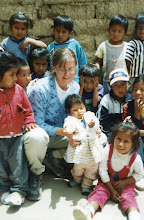
My friend Rick likes photos of things one wouldn't normally see in everyday life in the U.S. He liked various photos that I have taken and encouraged me to take more, I have been gathering photos since the beginning of the year. I met the woman in the above photo years ago when I first lived in Bolivia, she is the neighbor of my friend Berta. Recently when I went to Sacaba for a visit I found her right next to Berta, basically in the gutter of the street selling her produce, while she sits on the curb. Her layout is typical for a small time vender, small bunches or piles costing 1-2 bs (bs = bolivianos the currency here, 1 bs equals about 15 US cents) Many people shop just for the day's needs so small amounts are just right for soups.

Many people vend from carts, this one carries roasted nuts, beans, peas, and grains. Some people keep their carts at one location, others move from spot to spot, usually calling out what they have for sale. Since I didn't know the man I only asked to take a picture of his cart and not of him also. I know someone who had tomatoes thrown at them for not asking to take a picture! Below is a close up of the cart.

I could do a blog just on carts. There is the fresh squeezed o.j. vendor, ice cream of various types, popcorn, hotdogs, pizza, socks, cooking utensils, locks, dish towels... Okay just writing the list could take a blog, but you get the idea. If you can sell it, you can find it on a cart!

Can you name this? It's called charqui here, I would call it jerky. Sort of sounds alike! The old solar dryer (aka clothes line) doubles quite well for preparing charqui. My friend Olga was drying some on one of my last visits. When we were without electricity for a week, Fr Edwin suggested we make charqui out of all the meat that was in the freezer of the comedor (lunch program). I was glad it was the end of the month, because we would not have had enough time nor clothes lines to dry the 80 lbs of monthly beef.

The photo to the right is of Tunta, I am told, I write this because if I ask different people the will tell me different things. After harvest the potatoes are put in a mountain stream in the winter for 2-3 weeks, this cleans them and also begins the freezing process. The white ones are called tunta, when they are just freeze dried they are called chuño. Chuño which is darker gets foot pressed, like making wine, but to get all the water out. It is a way to preserve the potatoes long term. There are many national dishes made with chuño and tunta.

My friend Doña Berta sells Mote in a wheelbarrow covered with heavy plastic. She is too shy so no picture in the blog, so just her wheelbarrow. Some people say mote is only cooked giaganic kernels of corn, but when you ask people what they are selling they will say mote. Mote is a cooked bean, that people buy as a snack food, just peel off the outer skin and pop the inner into your mouth, it is very nutritious. Berta use to make a living hand washing clothes. The investment in the wheel barrow was a large one for her family, but one well worth it. She can make as much profit by wheeling her cart around town, and parking for periods, as she did in the hard labor of washing clothes. She says she also likes that she can hang out with her friends while selling, so a boost to her spirit as well.

Lots of fruit is sold from wheelbarrows too! Here we have peaches and grapes. Right in the city center, usually women roll wheelbarrows around with seasonal fruit, it is usually a little more expensive. Larger carts pushed by people on bikes sell fruit. Also pickup trucks make the rounds of the neighborhoods with larger quantities, announcing their producer from speakers, that one can hear from blocks away. Another blog that I have been wanting to do one the sounds of Bolivia!



